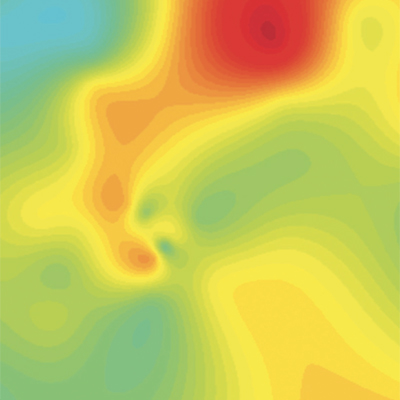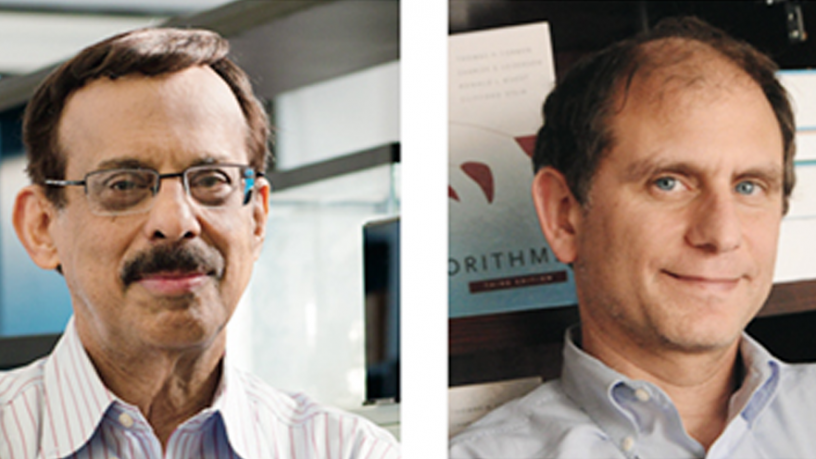Outside-of-the-Box Green Research
Climate experts and environmental engineers are not the only ones chipping away at the grand challenges posed by climate change. Through the study of big data, minerals, materials, and beyond, the following Columbia Engineering professors are working beyond their area of expertise and making important contributions in environmental sustainability.

Paste samples for isothermal calorimetry tests to determine the effect of replacing cement with carbonated minerals on hydration kinetics and setting properties. (Photos by Jeffrey Schifman)
Shiho Kawashima
Assistant Professor, Civil Engineering and Engineering Mechanics
Kawashima studies the rheology of one of the most frequently used materials in the world: concrete. Cement production makes up 5 percent of the world’s manmade carbon emissions, so, to this end, she has been working on ways to control the stability of concrete before it sets to improve its long-term performance properties.
“Good placement of the material can effectively increase the service life of the structure, and that is one key approach to making concrete more environmentally friendly—make it last,” says Kawashima.
She is collaborating with fellow engineer Alissa Park, associate professor of earth and environmental engineering and of chemical engineering, on research that combines her studies in cement-based materials with Park’s pioneering efforts in the field of mineral carbon sequestration. “We are looking to partially replace the cement content of concrete with an end product of mineral carbon sequestration and determine whether it can serve as an effective substitute material,” explains Kawashima. “This would reduce cement content and associated embodied energy and carbon, and contribute towards alleviating already-existing greenhouse emissions.”
Xiaofan (Fred) Jiang
Assistant Professor, Electrical Engineering
In 2012, Jiang was tapped to lead Intel’s new Internet of Things research lab in Beijing. On the drive to work one day, he had an idea. What if he could measure Beijing’s smog problem at a citywide scale?
Together with his team, Jiang built a system of low-cost sensors and distributed them throughout central Beijing. To compensate for the lower-quality data, they built a model that pulled in additional environmental information, such as temperature, humidity, and topography data, to improve sensor accuracy and generate fine-grained heat maps. Finished in less than a year, the AirCloud project was one of the first to provide an independent, real-time assessment of particulate pollution levels in Beijing.
Jiang is also focused on the idea of environmental accountability. “Buildings consume 72 percent of electrical energy in the nation,” he explains. “We waste more energy in commercial buildings than at home because we’re not accountable.” Jiang is working on a system that allows commercial buildings to quantify from where, and more specifically from whom, the most energy usage is coming.
 Air quality heatmap of Beijing in 2013, generated using custom sensors and spatial inference algorithms (Image courtesy of Fred Jiang)
Air quality heatmap of Beijing in 2013, generated using custom sensors and spatial inference algorithms (Image courtesy of Fred Jiang)
Ponisseril Somasundaran
LaVon Duddleson Krumb Professor of Mineral Engineering, Earth and Environmental Engineering
Going green is our social responsibility, says Somasundaran. In an article for Mining Engineering magazine, he noted: “Ultimately it may serve us all better to follow the spirit of the old Sanskrit saying, ‘Nishkama Karma,’roughly translated as selfless action. So I define sustainability as meeting the needs of the future generations, even if we have to forego some of our own perceived needs.”
This altruistic philosophy has guided Somasundaran in his work on sustainability, work that has included the creation of a quantifiable evaluation system to foster “greener” reagents. Various industries have tried to promote greener deeds but lacked a comprehensive definition of greenness. A robust evaluation tool or metric, therefore, is necessary to not only identify the major attributes that characterize greenness, but also calculate the greenness robustly and systematically. Factors such as toxicity, biodegradability, stability, cost, and social aspects all need to be considered in the evaluation. However, such a tool is not yet available or widely accepted. That’s where Somasundaran comes in. He and his team have established a Greenness Index tool that evaluates a reagent in an environmentally relevant way. The index uses a holistic approach by examining key features based on the 12 principles of green chemistry, the 12 principles of green engineering, and the International Council on Mining and Metals’s 10 principles of sustainable development. The Greenness Index project has been under constant development to provide meaningful assessment of reagents to promote the greening process in various industries.
Somasundaran is also exploring the potential toxicity of nanoparticles and their impact on our global footprint. His objective is to better understand these nanoparticles as they relate to performance as additives in water filters and sunblock, typical household and personal care products, an area in which research is much needed in order to foster the implementation of more sustainable practices.

L: Ponisseril Somasundaran; R: Clifford Stein
Clifford Stein
Professor, Industrial Engineering and Operations Research and Computer Science
“We all want to help in environmental issues and save energy,” says Stein. For his part, Stein, whose expertise lies in big data, is aiming to drastically decrease energy consumption by data centers.
As we advance technologically as a society, we have been able to craft hugely impressive processors that run at faster and faster speeds. But this comes with a substantial environmental cost—it is estimated that data centers account for 2 to 4 percent of the electricity usage in the United States, a number that will only increase with the trend to create bigger centers. Stein’s goal is to find a more environmentally friendly way to run these centers—cutting costs and energy use—without significantly compromising the performance of these centers.
He explores the problem on a theoretical level, using algorithms to determine how processors could perform with decreased levels of energy while maintaining quality of performance. Then he pilots these mathematical models; Stein has applied this work in a collaboration with Google. He has designed algorithms that schedule work in data centers while considering both performance and ways to decrease energy usage. These algorithms look to pack work onto fewer machines, allowing the unused machines to be placed in a low-power state.
Stein plans to apply the same kind of research approach to computer networking, another area in which energy consumption is trending upward as we grow otherwise more productive. “If routers are managed more efficiently, we could make substantial energy savings,” he notes. And those are savings that could have exponential effect.
The problems centered on environmental sustainability are just one area of research where SEAS faculty are making a huge impact on a global scale. From civil engineering and engineering mechanics to big data and more, Columbia engineers are certainly thinking outside of the box when it comes to solving some of Earth’s grandest challenges.
